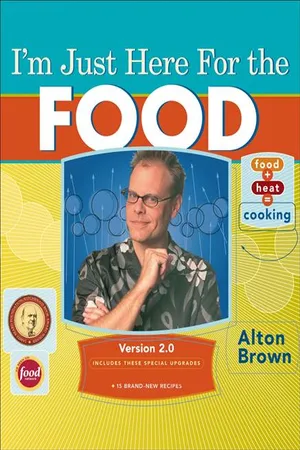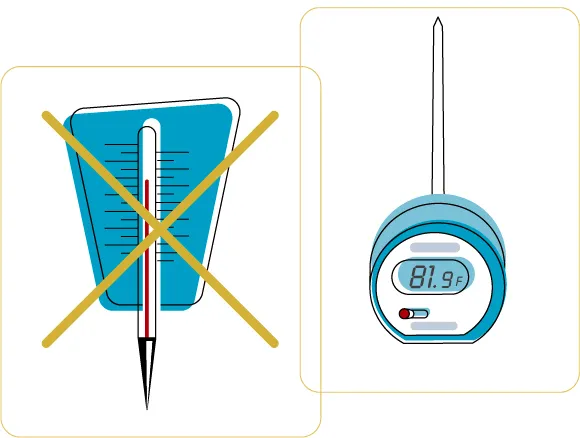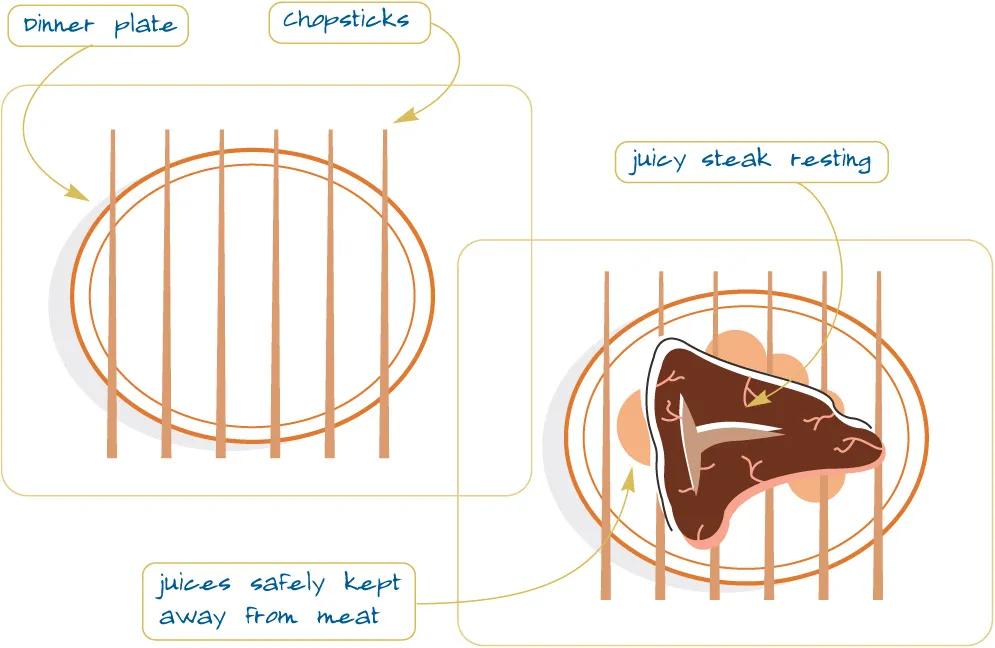![]()
The fastest way to get heat into food short of dipping it in hot lava … tastes better, too.
King Sear
This method creates a flavorful brown crust on the surface of many foods, the mere mention of which has been proven to activate saliva production in human test subjects (a fact not lost on the food service industry). What searing does not do is “seal in flavors” or “seal in juices.” If you feel it necessary to seal in juices you should buy a laminator.
HERE’S WHAT YOU NEED
A source of high heat. The average electric cook-top coil tops out at 2000º F. A gas flame—my personal favorite—can reach 3000º F. Searing can also be executed in a pan on the floor of a hot oven or on the exhaust manifold of a Formula One racing car (yes, it’s been done.)
A perfect vessel
Not only does the ideal searing surface (pan, skillet, and so on) have to get very, very hot, it has to get evenly hot all over and it has to be able to maintain that heat even in the face of foods. Several materials are ruled out from the get-go. Wood and paper make lousy searware because they tend to become fuel before they get hot enough to actually sear anything. Glass and ceramics are such lousy conductors of heat that they’re called “insulators.” Come to think of it, all the really great heat conductors are also great electrical conductors and they’re all metal. What’s so special about metals? Besides the fact that they can be molded, cast, and forged, they have a unique, crystal-like molecular structure. The atoms are locked in a uniform geometrical pattern, which makes metals (except mercury) pretty darned tough to bend or break. But their outer electrons are so weakly bound that they just wander around throughout the surface like quantum Flying Dutchmen, which is exactly what makes metals such good conductors. So when the electrons meet the heat on the bottom of the pan, they vibrate through to the other side, thus conveying the hot stuff to the cool stuff. Of course, this leads to the question: Which metal sears the best?
Copper is the hands-down winner when it comes to conductivity—that’s why we make wire out of it (that, and the fact that it’s easily extruded). Trouble is, purchasing copper cookware often requires taking out a small loan. And since copper is toxic in large amounts it has to be lined with either steel or tin, which tends to wear off. Save copper for where it’s really needed: a bowl (see Reactivity.)
Aluminum is also a righteous conductor. It’s economical and it’s light, but that’s a problem, because being light it lacks the density to hold a lot of thermal energy. That means it’s going to need some recovery time when something cold comes to call. Aluminum also reacts chemically with certain ingredients and eventually warps, so I’d skip it altogether.
Stainless steel is bright and shiny, durable, relatively inexpensive, and relatively easy to clean. Did I mention that it’s bright and shiny? But it’s not a great conductor because it’s an alloy, a mixture of several metals. And that means that instead of a neat and tidy molecular structure it looks something like this:
This makes it tough for electrons to get around. I still think stainless steel makes a swell sauté pan, but for searing I’ll hold out for iron.
Iron is dense—really dense—which makes it a relatively slow conductor. But that density also allows for even heating, and once it gets hot it stays hot.6 Iron is very economical, and cooking with it supplies dietary iron, which a lot of us (especially women) tend to run short on. Cast-iron pans must occasionally be seasoned, or cured, with a thin layer of hot fat in order to seal the surface against rust (see Cast Iron Feeding Instructions). Some folks sneer at the maintenance required, but considering that ours is the very culture that nurtured Sea Monkeys, Chia Pets, and Pet Rocks, taking care of an iron skillet shouldn’t be a problem.
THE MAKING OF CAST IRON
To cast iron, a pattern is made (a positive image of a pan, pot, or what have you). Then a mixture of sand and clay is packed around it under high pressure creating a mold, or cake. Molten iron is poured through a small opening in the cake. After the iron has solidified, the cake is broken open, revealing the newborn cookware. The sand is then broken up and reused.
CAST IRON FEEDING INSTRUCTIONS
1. Place the pan to be cured on the top rack of a cold oven and place a sheet pan or baking sheet on the bottom rack.
2. Turn the heat to 350° F.
3. When the pan is warm but still touchable, remove the pan and spoon in a dollop of solid vegetable shortening, which is more refined than other oils and won’t leave a nasty film. As the shortening melts, use a paper towel to smear the fat all over the pan, inside, outside, handle—everywhere.
4. Place the pan back in the oven, upside down. This prevents excess fat from pooling in the bottom and botching the cure.
5. Bake for 1 hour, then kill the heat and let the pan cool for a few minutes. (Use fireproof gloves when you remove the pan from the oven.)
6. Wipe the pan clean but don’t wash it until after you’ve used it.
That’s it. To clean a cast-iron pan, I usually add a little fat to the still-hot pan, toss in some kosher salt, and rub it with paper towels. If that doesn’t do the trick, I’ll wash it with mild detergent, warm water, and a sponge. I re-cure my cast-iron pans every New Year’s Day, whether I need to or not.
ADDITIONAL SEAR GEAR
Spray bottle Your standard buck-fifty drugstore pump bottle is the perfect tool for applying a thin coat of lubricant (cooking oil) to the surface of the food to be seared. Beware of fancy-looking mister bottles. I’ve had three and worn out three with only moderate use.
Spring-loaded tongs A pair of these is like having a big metal hand. Muzzle with a rubber band for low-profile storage. I keep a short pair for the kitchen and a long pair for the grill.
Instant-read thermometer Heat control is the cook’s primary directive, and yet there are a lot of cooks out there who do not own this simple device. This is like riding a motorcycle without a helmet, or owning a pit bull but not homeowner’s insurance, or working a government job without a shredder. It’s crazy. I’m not talking about the old metal-tipped glass tube with the metal paddle on it that you could have tapped a maple tree with. I am talking about a slender metal probe topped with a digital readout of some type. Analog models are also available, but they’re easily swayed out of concentration, so use them at your own risk.
Welding gloves Potholders are for sissies and mitts are for baseball. If I’m gonna grab a five hundred–degree pan, I want protection that reaches halfway to my elbow. Skip the kitchen shop and head to the hardware store.
Splatter guard As the pan gets hot it’s going to turn into a radiator. The air around it is going to get hot, expand, and rise, taking microscopic drops of grease with it. If you’ve got a really strong ventilation hood, these drops may get caught up in the draft and get on out of the house. Odds are, though, the air is simply going to cool down as it rises, allowing the particles to fall down onto any horizontal surface they can find. The best way to prevent this is by using a splatter guard. It’s basically a screen door for your pan.
Make sure you buy one wide enough to cover your widest sauté pan, because you definitely don’t want to pan fry without this device in place. Besides preventing clean-up nightmares, it’s also your own best protection against flying grease. (Don’t think this is an issue? Try frying bacon naked sometime.)
Fresh air Any time you get animal protein around very high heat there’s going to be some smoke. How much depends on the fat content of the meat. So turn your exhaust fan on, and if you don’t have one, open a window and maybe a door. If for some reason you have a smoke detector right over the cook top (though I can’t imagine why you would), take the battery out until you’ve finished cooking.
Wooden chopsticks If you’re not going to rest your meat, you might as well not cook it. Make your own resting rack anywhere, anytime, with these amazing sticks! Take your average dinner plate. Place five or six chopsticks thusly:
Now you’ve got the perfect place to rest a wide variety of your favorite meats. You should, of course, keep them cozy under a loose layer of foil.
REACTIVITY
When we talk about “reactive” metals these days, we’re talking about aluminum and maybe copper. Metals such as stainless steel are actually surrounded by a very thin layer (a few molecules thick, tops) of oxide that is created at the point where metal and air meet. Despite the fact that it’s technically gas, this film creates a formidable barrier between food and pan.
The film around aluminum is very vulnerable to acid. When acidic foods ar...







